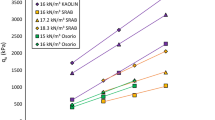Abstract
The constructional activities on peat soil are avoided which is due to its poor load-bearing capacity and high compressibility. Therefore, it always requires making the peat conducive in terms of its both strength and compressibility so as to undergo an infrastructural operation over it. However, apart from strength and compressibility criteria, there lie other two parameters (i.e., pH and electric conductivity) which also need to give emphasis while making any constructional activity over it. This paper studies the importance of accounting the pH and electric conductivity (EC) of peat soils as a significant parameter from the constructional point of view. Moreover, the change in behavior of pH and EC with cement addition is also analyzed. Simultaneously, it also attempted to make a correlation between this two which finally can help to understand the process of peat-cement reactions. From the results, it has been seen that pH and electric conductivity are a good indicative parameter through which the variations of other important parameters can be related. Finally, from the correlation, it is seen that irrespective of all curing days, the electric conductivity increases with increase in pH. However, this increase in EC with pH increment is found to be high at higher percent of cement.
Access this chapter
Tax calculation will be finalised at checkout
Purchases are for personal use only
Similar content being viewed by others
References
Arulanandan K, Muraleetharan KK (1988) Level ground soil liquefaction analysis using in situ properties. J Geotech Eng 114(7):753–770
Asadi A, Huat BBK (2009) Electrical resistivity of tropical peat. Electron J Geotech Eng 14:1–9
Abu-Hassanein HS, Benson CH, Blotz LR (1996) The electrical resistivity of compacted clays. J Geotech Eng 122(5):397–406
Bryson LS, Bathe A (2009) Determination of selected geotechnical, properties of soil using electrical conductivity testing. Geotech Testing J 32(3):1–10
Eriktius DT, Leong EC, Rahardjo H (2001) Shear strength of peaty soil-cement mixes. In: Proceedings of the third international conference on soft soil engineering, Hong Kong, 551–556
Huat BBK, Afshin A, Kazemian S (2009) Experimental investigation on geomechanical properties of tropical organic soils and peat. Am J Eng Appl Sci 2(1):184–188
Kolay PK, Aminur MR, Taib SNL, Zain MISM (2011) Stabilization of tropical peat soil from Sarawak with different stabilizing agents. Geotech Geological Eng 29:1135–1141
Kalinski RJ, Kelly WE (1993) Estimating water content of soils from electrical resistivity. Geotech Test J 16(3):323–329
Ponziani M, Slob EC, Nagen-Tillard DJM, Vanhala H (2011) Influence of water content on the electrical conductivity of peat. Int Water Technol J 1(1):14–21
Muller PG, Coutts JA (2005) Acid sulfate soils and estuarine water quality of the Mackay district. Land Res Bull 1:77
McCarter WJ (1984) The electrical resistivity characteristics of compacted clays. Geotechnique 34(2):263–267
McCarter WJ, Desmazes P (1997) Soil characterization using electrical measurements. Geotechnique 47(1):179–183
Mukhtar F, Bhat MA, Bashir R, Chisti H (2014) Assessment of surface water quality by evaluating the physico-chemical parameters and by checking the water quality index of Nigeen Basin and Brari Nambal Lagoon of Dal Lake Kashmir. J Mater Environ Sci 5(4):1178–1187
Rowe RK (ed) (2012) Geotechnical and geoenvironmental engineering handbook. Springer Science and Business Media
Rahman ZA, Lee JYY, Rahim SA, Lihan T, Idris WMR (2015) Application of gypsum and fly ash as additives in stabilization of tropical peat soil. J Appl Sci 15(7):1006–1012
Robert BG, Mark Alley WGW, Holshouser D, Thomason W (2009) Precision farming tools: soil electrical conductivity. Virginia cooperative extension, Virginia, 442–508
Rahgozar MA, Saberian M (2016) Geotechnical properties of peat soil stabilised with shredded waste tyre chips. Mires Peat 18:1–12
Taku KJ, Amartey DY, Kassar T (2015) Effect of acidic curing environment on the strength and durability of concrete. Civ Environ Res 7:8–13
Author information
Authors and Affiliations
Editor information
Editors and Affiliations
Rights and permissions
Copyright information
© 2022 Springer Nature Singapore Pte Ltd.
About this paper
Cite this paper
Paul, A., Hussain, M. (2022). pH and Electrical Conductivity of Cement-Treated Peat. In: Dey, A.K., Mandal, J.J., Manna, B. (eds) Proceedings of the 7th Indian Young Geotechnical Engineers Conference. IYGEC 2019. Lecture Notes in Civil Engineering, vol 195. Springer, Singapore. https://doi.org/10.1007/978-981-16-6456-4_19
Download citation
DOI: https://doi.org/10.1007/978-981-16-6456-4_19
Published:
Publisher Name: Springer, Singapore
Print ISBN: 978-981-16-6455-7
Online ISBN: 978-981-16-6456-4
eBook Packages: EngineeringEngineering (R0)




